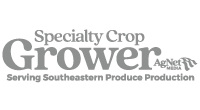By Maegan Beatty
North Carolina is a large contributor of specialty crops in the southeast. From peaches to seedless watermelon, the state grows a diverse set of fruits and vegetables for most of the year. In a recent interview with AgNet Media, North Carolina Commissioner of Agriculture Steve Troxler provides an optimistic outlook for 2025 and how the specialty crop industry in the state will continue to grow.
What is Outlook on Specialty Crop Industry for 2025?

“Looking at USDA information, I am seeing that specialty crops cash receipts are projected to be up a bit, including 4.6% for vegetables, melons and potatoes, and I hope that is the case,” Troxler said.
Troxler has a positive attitude about the future of the specialty crop industry for North Carolina in 2025, yet he understands the challenges that growers continue to face.
“In surveying some of our specialty crop producer associations, I would say tempered optimism is what comes to mind. Farmers by nature are optimistic and hopeful the upcoming year will be better than the last. High input costs continue to be worrisome for farmers as the profit margin on some specialty crops are especially thin or even non-existent when yields are down, like what happened in 2024. Access to labor and the costs of labor are other issues of concern for growers,” Troxler stated.
What Struggles Did Industry Face This Past Year?
“Farmers are not immune to the price increases in products that everyone faces, but the price farmers receive for their commodities hasn’t increased. Access to labor is also an issue for the specialty crop industry as many of these crops are labor intensive to harvest,” Troxler said.
How Did Hurricane Helene Affect the Industry?
“North Carolina producers (not just specialty crops) took a major hit from Hurricane Helene and these other weather events, with combined damage totals estimated at around $5 billion. For example, sweet potatoes experienced decreased crop yields due to the untimely wet weather,” Troxler said.
Troxler mentioned that across the state, tomato growers faced projected losses of $15.3 million; apple growers had projected losses at $10 million; and in Henderson County alone, there were projected losses at around $39 million, with the majority being specialty crops.
Are There Any Reasons for Optimism?
“I do believe there is reason for optimism. We continue to see strong consumer interest in buying locally sourced fruits and vegetables, plus there has been a growing trend focused on healthy eating and lifestyle. Our state is one of the most agriculturally diverse states in the nation, so farmers are producing a variety of specialty crops. North Carolina is also positioned in a way that perfectly fills the needs for quality produce at a time that most regions are out of season,” Troxler said.
Within this new year, Troxler said that their state-operated and regional farmers markets intend to increase in partnership to develop a growing interest in agritourism, consumer awareness and sales.
What is the Biggest Concern for the Specialty Crop Industry Heading Into This Year?
“I have mentioned high input costs and access to labor, but financial pressure is also significant especially following Hurricane Helene. Farmers are seeking operating loans to start their 2025 season, and financing requirements are getting tougher, and costs are up,” Troxler stated.
“A major issue across all growers is the recovery of the secondary and farm roads. These roads, as opposed to the major highways, are not addressed in the FEMA coverage.”
Is There Anything Else You Would Like to Add?
“The need for consumer education remains critical to help people understand production agriculture better and how production doesn’t stop and restart quickly. For some crops, we are looking at several years of growth before they start to bear fruit,” Troxler said.










